Narcisse-Virgile Diaz de la Pena (1808-1876)
Get a Diaz De La Pena Certificate of Authenticity for your painting (COA) for your Diaz De La Pena drawing.
For all your Diaz De La Pena artworks you need a Certificate of Authenticity (COA) in order to sell, to insure or to donate for a tax deduction.
Getting a Diaz De La Pena Certificate of Authenticity (COA) is easy. Just send us photos and dimensions and tell us what you know about the origin or history of your Diaz De La Pena painting or drawing.
If you want to sell your Diaz De La Pena painting or drawing use our selling services. We offer Diaz De La Pena selling help, selling advice, private treaty sales and full brokerage.
We have been authenticating Diaz De La Pena and issuing certificates of authenticity since 2002. We are recognized Diaz De La Pena experts and Diaz De La Pena certified appraisers. We issue COAs and appraisals for all Diaz De La Pena artworks.
Our Diaz De La Pena paintings and drawings authentications are accepted and respected worldwide.
Each COA is backed by in-depth research and analysis authentication reports.
The Diaz De La Pena certificates of authenticity we issue are based on solid, reliable and fully referenced art investigations, authentication research, analytical work and forensic studies.
We are available to examine your Diaz De La Pena painting or drawing anywhere in the world.
You will generally receive your certificates of authenticity and authentication report within two weeks. Some complicated cases with difficult to research Diaz De La Pena paintings or drawings take longer.
Our clients include Diaz De La Pena collectors, investors, tax authorities, insurance adjusters, appraisers, valuers, auctioneers, Federal agencies and many law firms.
We perform Narcisse-Virgile Diaz De La Pena art authentication, appraisal, certificates of authenticity (COA), analysis, research, scientific tests, full art authentications. We will help you sell your Narcisse-Virgile Diaz De La Pena or we will sell it for you.
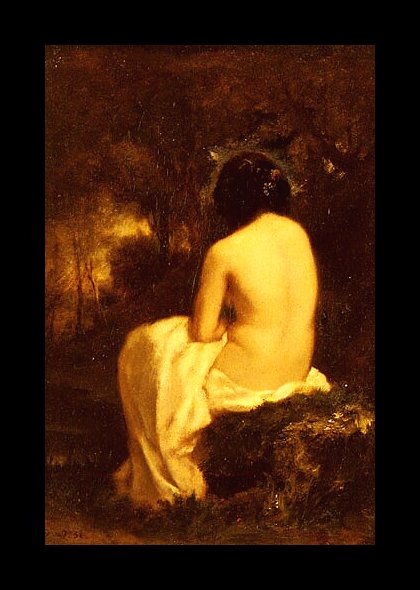
Narcisse-Virgile Diaz de la Pena was one of the founding members of the Barbizon school. A sad set of circumstances marked his early life. He was born in Bordeaux to Spanish parents, hence his name. At the age of ten he was orphaned and brought up by a priest in Bellevue near Paris. During his teenage years he had to have one of his legs amputated due to blood poisoning. At the age of fifteen he was apprenticed to a pottery decorator. It was whilst here that he also took to painting Eastern figures in richly coloured garments.
He undertook his artists training like many artists of the day at the Louvre, where he copied the great works of art there. He was particularly inspired by the Italian High Renaissance painter Antoine de Correggio, who painted many mythological scenes and in particular his painting, ‘Antiope’, which hangs in the Louvre. He interpreted this painting in his own, ‘Nymphe Endormie’ which also now hangs in the Louvre. He was also inspired by the eighteenth century painters of the ‘fetes-galantes’, He admired Watteau and his painting ‘The Clown’, which hangs in the Phoenix Museum of art is composed of elements of Watteau’s painting’Gilles’.
He also admired enormously the work of Eugene Delacroix, particularly his orientalist paintings, and also his paintings of nymphs. He was to incorporate these orientalist themes into many of his paintings. His lameness meant he could not travel extensively, as the other artists that he admired had done. He used his imagination and the paintings of others such as Delacroix for inspiration when he was approaching orientalist themes.
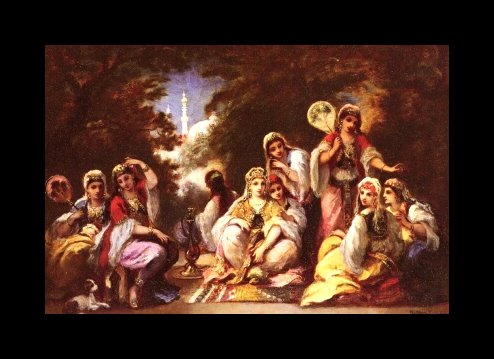
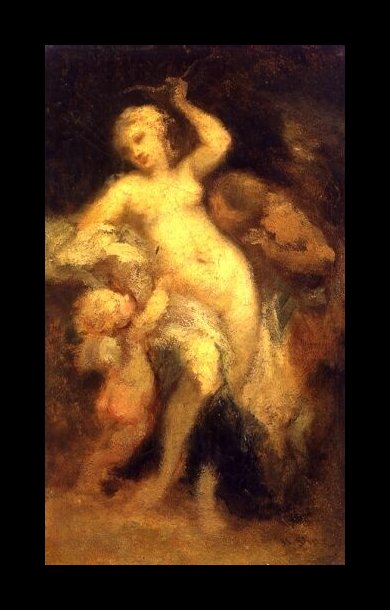
Narcisse-Virgile Diaz de la Pena was initially known for his figure painting, until 1837 when he was to became a core member of the Barbizon school, and became good friends with Theodore Rousseau whom he admired greatly. During this time he was particularly known for his depiction of the dark, somber woodlands which he juxtaposed with the light. He was to incorporate his interest in orientalism into these scenes such as in the painting which hangs in the Museum of Fine Arts in Boston, ‘Bohemians going to a Fete’, which depicts exotically dressed figures descending through the Forest for a picnic. It is paintings such as these, with mythical and oriental elements that probably distinguish him from other members of the Barbizon school. This painting in particular brought him success in the Salon. He was to become a very successful artist of the day. He won three Gold medals at the Salon, and was also made a Knight of the Legion of Honour in 1851.
Due to the success of his paintings he was also quite financially well of. He was to help out a number of his artist friends of the Barbizon school such as Theodore Rousseau and Jean Francois Millet. It seems that he was an incredibly kind and gentle character. The Impressionists were of course particularly inspired by the painters of the Barbizon School, and the way in which these painters handled the light. He was to become particularly friendly with the young Renoir who went to the Forest of Fontainebleau to paint, and as well as giving him advice he also paid for canvases and pigments for him.
The Louvre has a substantial collection of works by Narcisse-Virgile Diaz de la Pena, as does the Wallace Collection in London.
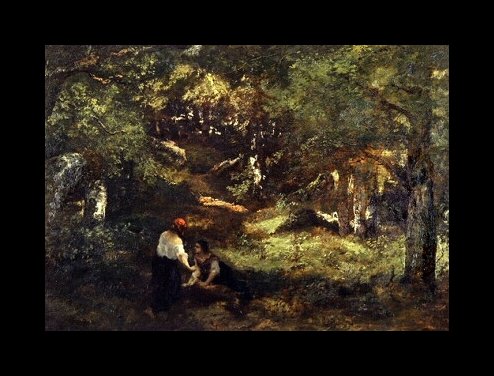
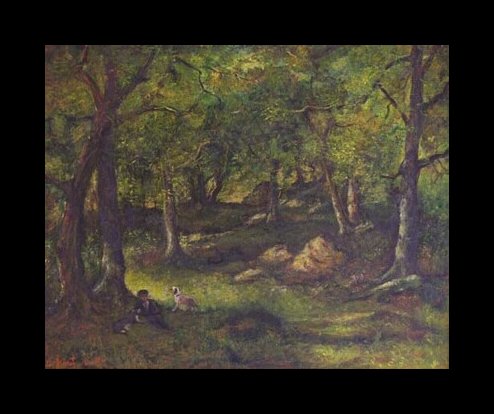
Reviews
1,217 global ratings
5 Star
4 Star
3 Star
2 Star
1 Star
Your evaluation is very important to us. Thank you.
